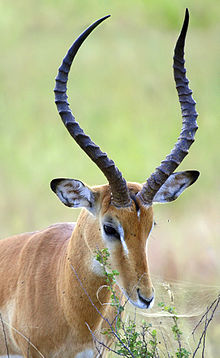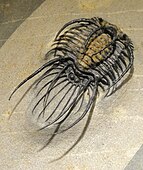Weapon (biology)

In
Many weapons evolve through
Since Darwin's publication The Descent of Man, extensive research has been done on the presence of agonistic behavior and the usage of animal weaponry by different species.[1] Weaponry displays in animals have been found to increase their likelihood of survival in different ways, such as when interacting with other individuals or trying to find another mate, or to defend against predators.[2]
Occurrence

Weapons are common among many genera of animals. Among
In mammals, weapons are common and take a number of diverse forms. They are most common among the

Some species of fish have weapons, though these traits are not as widespread as in mammals. Sawfish are named for their long rostrum, which can be used to inflict damage on other fish.[8] Unicornfish may also use their strange horn-like forehead protection as a weapon, although the general use of this and many similar structures in fish are still somewhat enigmatic. [5] Male salmon notably feature intraspecific competition for mates, and they use their elongated and toothy jaw to fight other males, both over access to females and over access to breeding sites.[5][9][10]
Weapons are very widespread among insects, having been observed in nearly every major taxonomic group.
Evolution

Animal weaponry is capable of drastic and rapid diversification in form, with closely related species, even within the same clade, having distinctly different weaponry.[5] One hypothesized mechanism for this is the gradual change in weaponry function from purely physical agonistic behavior, to a stronger emphasis on display, resulting in potentially more elaborate weapons. For instance, many dinosaurs may have had structures that were once weapons but were later used as ornaments to attract mates.[5] Another possible mechanism is the presence of male-male combat, with diverging lineages of animals expanding into different habitats and then fighting under different conditions. Changes in the physical contest between species in different environments may potentially drive the evolution in modified weaponry. Sites that have localized, defendable resources, like a single food or water source, or a breeding burrow, often are where species with weapons are found.[5]
Sexual selection has been a main focus on weaponry and antagonist interactions between animals, with males that present the largest weapons having the highest probability of winning.[17] Sexual selection has been credited by previous researchers as the main influence of nature's extravagant weaponry for the purpose of attractive females.[5] During agonistic interactions, there is the potential risk of weaponry lost resulting in a possible decrease in an individual's fighting ability and overall fitness.[17]

Most animal weapons probably emerged independently. The weapons of ungulates, for instance, are believed to have evolved independently during the
An exception to the general independence of weapon evolution is found in
Usage & Characteristics
Agonistic behaviors amongst animals for resources have been studied by many researchers, and specifically the interaction of weapons during these exchanges of behavior.[1] Not only the presence of weaponry, but also specific characteristics of the weaponry itself can have an effect on the outcome of competition in determining the winners and losers from an intraspecies competition.[5] The display of weaponry has been found to be favored in animals that frequently engage in contest as a mechanism to decrease the costs of aggression.[5]

Most weapons that are studied are utilize to injure other individuals. These include the most famous weapons, such as antlers, horns, and mandibles; conversely, some animals have specialized "weapons" that actually fulfill a defensive role, such as the horned
Female Weaponry
Since the publication of The Descent of Man and The Origin of Species, research has been heavily focused on weaponry in male animals, potentially leaving out females and their possible mechanisms behind present weaponry.[23] Presence of weapons in females, and female-female competition has been seen in many species for better fitness of both sexual and social selection.[24][23] Social selection, first hypothesized by Mary Jane West-Eberhard, is a broader term that includes both sexual and non sexual behaviors to increase an individual's fitness.[23] For example, research has suggested that horns present in female bovids, may have evolved from competition for resources such as food.[24]
Gallery
-
Antlers of a red deer
-
Mandibles of a stag beetle
-
Ossicones of a giraffe
-
Rhinoceros horns
-
tusked wētā
-
Spines of a trilobite
References
- ^ S2CID 250282536.
- ^ PMID 30010939.
- ^ PMID 33499793.
- ^ Krebs, J. R., and Nicholas B. Davies. "Sexual Selection, Sperm Competition and Sexual Conflict." An Introduction to Behavioral Ecology. 4th ed. Oxford: Blackwell Scientific Publications, 2012.
- ^ ISSN 1543-592X.
- .
- JSTOR 2387253.
- .
- JSTOR 2386541.
- .
- .
- PMID 31618906.
- JSTOR 2388476.
- .
- ^ Perez, D. M., Rosenberg, M. S., and Pie, M. R., 2012, The evolution of waving displays in fiddler crabs (Uca spp., Crustacea: Ocypodidae): Biological Journal of the Linnean Society, v. 106, p. 307-315.
- ^ Callander, S., Kahn, A. T., Maricic, T., Jennions, M. D., and Backwell, P. R. Y., 2013, Weapons or mating signals? Claw shape and mate choice in a fiddler crab: Behavioral Ecology and Sociobiology, v. 67, p. 1163-1167.
- ^ S2CID 253820366.
- .
- .
- .
- PMID 10885518.
- .
- ^ PMID 22777016.
- ^ PMID 19759035.








